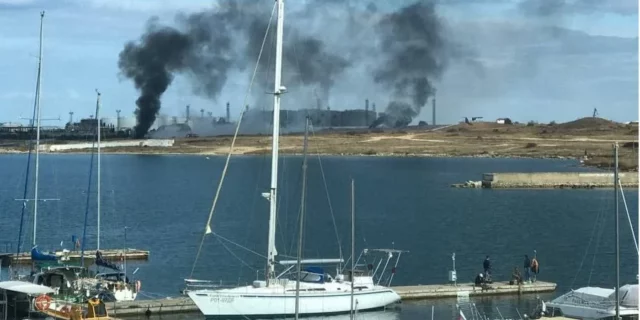John C. K. Daly

Eight months after Russian President Vladimir Putin began his unprovoked “special military operation” against Ukraine, one of the most striking emerging aspects of the conflict has been the Ukrainian Armed Forces’ surprising and increasingly effective denial of Russian naval efforts to establish “command of the sea” in the Black Sea. With an unexpected anti-ship missile attack on April 13, the Ukrainians sank the Black Sea Fleet’s (BSF) flagship, the Soviet-era Slava-class Moskva guided missile cruiser. In its most impressive operation yet, on October 29, the Ukrainian military launched a coordinated swarm of unmanned aerial vehicles (UAVs) and naval drones into Sevastopol, headquarters of the BSF for over two centuries. While the apparent level of damage was slight, the technological prowess of the attack on the highly symbolic target led Russia to assert that the Ukrainian military had received foreign assistance before and during the operation.
The Russian Ministry of Defense (MoD) briefed journalists that the attack occurred at 4:20 a.m. on the morning of October 29, when nine UAVs and seven unmanned robotic naval drones traveled 100 miles from their Ochakiv launch point, near Odesa, to Sevastopol on the Crimean peninsula, which Russia has occupied since 2014. The MoD asserted, “As a result of the operational measures taken by the ships of the Black Sea Fleet, all air targets were destroyed.” Four marine drones were destroyed by BSF weaponry and aviation, while the remaining three were destroyed in the port’s roadstead. The MoD stated that only the Ivan Golubets minesweeper and the boom-mesh barrier in the South Bay experienced minor damage (TASS, October 29).
The implications of this attack reverberated throughout the war zone. In response, Sevastopol Governor Mikhail Razvozhaev said, “Tonight, the most massive attack in the history of the SVO [“special military operation”] by UAVs and remote-controlled surface vehicles on the waters of Sevastopol Bay was undertaken” (TASS, October 29). Razvozhaev added, “The enemy tried to strike at the military infrastructure of the Black Sea Fleet. All unmanned vehicles were detected and destroyed in advance.” According to the Russian governor, Sevastopol’s BSF air defenses engaged the UAVs for several hours (T.me/razvozhaev, October 29). The assault proved to be a major embarrassment for the Russian Navy, as the BSF’s new flagship, the Admiral Grigorovich-class frigate Admiral Makarov, was reportedly damaged and possibly disabled during the audacious drone raid—the consequences of which were as determinedly downplayed in the Russian media as much as they were highlighted in the Ukrainian information sphere (Novoye vremya, October 30)
In an explosive assertion, the MoD subsequently claimed that British specialists were directly involved in the Sevastopol attack. In a statement posted on October 29 on its Telegram account. the ministry declared, “It should be stressed that the ships of the Black Sea Fleet that were subjected to the terrorist attack are involved in ensuring the security of the ‘grain corridor’ as part of the international initiative to export agricultural products from Ukrainian ports. The preparation of this terrorist act and the training of the military personnel of the Ukrainian 73rd Special Centre for Maritime Operations were carried out under the guidance of British specialists located in the city of Ochakiv in Ukraine’s Mykolaiv region” (T.me/mod_russia, October 29).
The raid swiftly produced consequences; on October 31, the Russian government announced that it was suspending its participation in the United Nations–brokered arrangement that allowed civilian merchants to export Ukrainian grain and fertilizer from several of Kyiv’s Black Sea ports, which were earlier under blockade by the Russian Navy. This came after the MoD reported that the drones had initially used the maritime “grain corridor” security zone before changing course toward Sevastopol (Izvestiya, November 1). As merchants nevertheless continued their participation in the transit of grain through the designated corridor, Russia rejoined the initiative two days later.
In the wake of the attack, the Russian military also quickly began to intensify its missile attacks on Ukraine’s aging and increasingly decrepit Soviet-era energy infrastructure, which quickly disabled up to a third of the country’s electricity generation capacity and began causing rolling blackouts (Tvzvezda.ru, October 31).
The Black Sea is proving to be a tactical and technological arena that is upsetting long-standing regional strategic assumptions, starting with Russia’s presumed prowess and naval superiority over Ukraine. The Moskva’s loss was the first time Russia had lost a flagship since the disastrous 1905 Tsushima battle during the Russo-Japanese War and the Russian Navy’s largest warship sunk in combat since 1945. Ukraine’s innovative tactics reaffirmed that, since the 1982 Falklands conflict three decades ago, the ongoing and increasing combat value of sea-skimming missiles should not be disregarded. Russia’s entire BSF now appears vulnerable to remote warfare, as Ukrainian forces have demonstrated their ability to mount effective long-distance strikes as far as Crimea. Other strikes of this nature include strikes on the Kerch Bridge connecting the peninsula with Russia, on Crimea’s Saky airfield and, two months ago, on the BSF’s headquarters building in Sevastopol.
Ukrainian President Volodymyr Zelenskyy has vowed to liberate Crimea with all of the occupied southern and eastern territories of Ukraine, ambitious goals that were earlier derided by many in the international community. Now, in the wake of recent events, these fears seem marginally less implausible. What is certain, however, is that for Ukrainian civilians suffering intermittent reliability in the supply of water, electricity and gas, they are likely to suffer mot as the Russian military increasingly focuses on “softer” civilian infrastructure targets. 




No comments:
Post a Comment